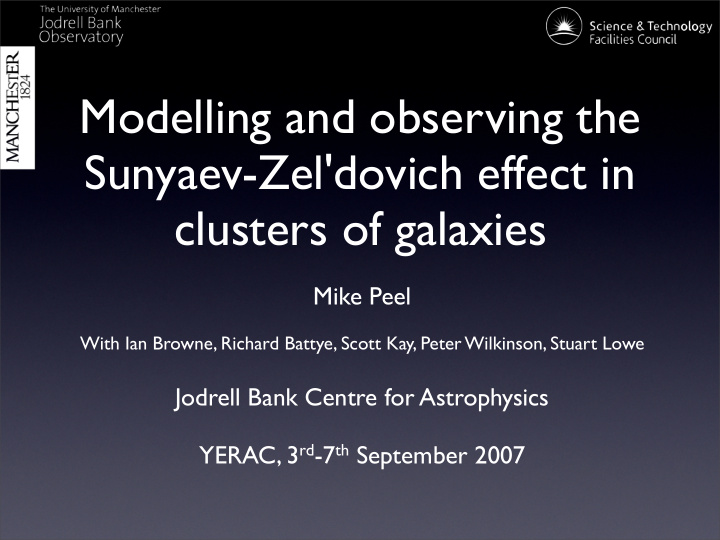



Modelling and observing the Sunyaev-Zel'dovich effect in clusters of galaxies Mike Peel With Ian Browne, Richard Battye, Scott Kay, Peter Wilkinson, Stuart Lowe Jodrell Bank Centre for Astrophysics YERAC, 3 rd -7 th September 2007
Outline 1. Clusters of galaxies 2. Virtual Sky simulations a. Cosmology b. Cluster model c. Foregrounds and noise 3. The One Centimeter Receiver Arrays 4. Future work
1. Clusters of galaxies Coma Cluster (Abell 1656) at 645nm From the Digitized Sky Survey
1. Clusters of galaxies Coma Cluster (Abell 1656) at 0.15nm From Einstein Jones and Foreman, 1999, ApJ 511:65
1. Clusters of galaxies CL 0016+16 at 1cm from OVRO Millimeter Array Greyscale: X-ray emission from ROSAT Carlstrom et al., 1996, ApJ 456:L59
1. Clusters of galaxies Schematic cluster diagram Black = galaxies Blue = X-ray emission Yellow = SZ effect White = dark matter
1. Clusters of galaxies Cosmological probes • Suggests CMB is primordial 1 • Can measure distances and the Hubble parameter 2,3 • Number counts can be used to obtain cosmological parameters 4 • Problem: confusion 5 1: Birkinshaw, 1999, Phys. Rep. 310:97 2: Reese et al., 2002, ApJ 581:53 3: Birkinshaw et al., 1991, ApJ 379:466 4. Battye & Weller, 2003, Phys. Rev. D 68:083506 and references therein 5. Lancaster et al., 2004, MNRAS 359:16
2. Building a Virtual Sky a. Cosmology • CMB anisotropies from the power spectrum (from CAMB) 1 • Either randomly distribute clusters, or use N-body simulations, e.g. Pinocchio 2 • Use theoretical mass and redshift distributions 3 1: Lewis et al., 2000, ApJ 538:473; www.camb.info 2: Monaco et al., 2002, MNRAS 331:587 4. see e.g. Battye & Weller, 2003, Phys. Rev. D 68:083506
2. Building a Virtual Sky b. Cluster model • Know θ , ϕ , z, M • Need to calculate n e (r), T e (r) • Two cluster components - gas and dark matter - so two profiles • Assume isothermality, standard profile, spherical symmetry to create a cluster model 1 1. e.g. Battye & Weller, 2003, Phys. Rev. D 68:083506
2. Building a Virtual Sky An example
2. Building a Virtual Sky c. Foregrounds and noise • Dusty galaxies (infrared point sources) • AGN (radio point sources) • + other unresolved sources • Our galaxy • Tropospheric turbulence • Receiver noise and imperfections
2. Building a Virtual Sky With point sources
2. Building a Virtual Sky Without point sources
3. The One Centimeter Receiver Arrays Image credit: Stuart Lowe OCRA-p (prototype) OCRA-F (FARADAY)
3. The One Centimeter Receiver Arrays 32m telescope at the Torun Centre for Astronomy
3. The One Centimeter Receiver Arrays Simulated scan across a point source from an OCRA-F pair
3. The One Centimeter Receiver Arrays • Results so far: • Lowe et al. (2007), “30 GHz flux density measurements of the Caltech-Jodrell flat- spectrum sources with OCRA-p”, arXiv: 0707.3368 • Lancaster et al. (2007), “Preliminary Sunyaev-Zel'dovich observations of galaxy clusters with OCRA-p”, MNRAS, 378, 673 ... and more to come
4. Future work • Improvements to the (Virtual) Sky • Understanding and modeling the 30GHz atmosphere • Optimising the observational strategy • Commissioning of OCRA-F • Blind surveys for point sources • Follow-up for Planck cluster survey • First blind survey for SZ clusters? ... watch this space in 2008!
Recommend
More recommend